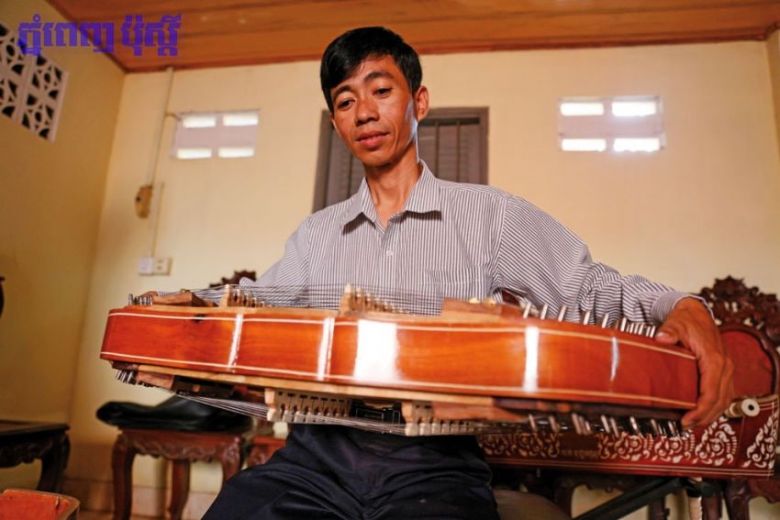September 14, 2022
PHNOM PENH – Two models of “twin” traditional Khmer instruments, the twin takhe and the twin khim, were developed in 2014 by a Phnom Penh geography teacher. He aims to debut updated, easier to play versions of his instruments by the end of this year.
Sak Bophavan, who teaches 12th grade at Bak Touk High School, told The Post that he began working on his idea in 2011, but first debuted them – and received recognition from the Ministry of Culture and fine Arts – in 2014.
The 52-year-old explained that the updated models were smoother to play than his original concepts.
“I don’t have anyone to assist me with my work. A lack of time, combined with my advancing age, means I am only able to work on the project little by little. If I was able to concentrate on it full-time, I could be done in a month, but as it stands, I think they will be ready by October – or the end of the year at the latest,” he said.
His twin takhe is a new take on the traditional Cambodian musical instrument. Although based on the traditional three or four stringed version, Bophavan’s has a useful feature, which he believes renders it more flexible than the original.
Like most takhe, the instrument is made from the timber of the jackfruit tree and has a large body, which rests on its own legs – essentially resembling an oversize lap guitar with a hollow body. The thing that makes the twin edition special is the division of its frets into two parts: 12 frets are Khmer tones, and 21 are the western musical scale, which means a player can switch between the two.
The khim is a flat stringed board, with the strings played with light bamboo hammers. Like his takhe, Bophavan’s can be played in Khmer and western tones. He worked on the khim design with his eldest son, Bophavann Chetha Udom, in 2012.

Originally a guitarist, Bophavan was once asked by a foreigner, “If you are Khmer, why don’t you know how to play Khmer instruments?” This made him think about what he could do to preserve his culture, and he began to study traditional instruments. Once he was proficient, he bought his own to play at home with friends. Eventually, his eldest son joined them.
“When we first started playing Khmer instruments, my son wanted to play the khim. The others preferred the tro, so I was left with the takhe. To be honest, I don’t mind which one I play – I love all traditional Khmer instruments,” he said.
“After we had been playing for a while, I realised that we were limited in that we could only play traditional music. It was very difficult to adapt them to modern songs. This was how I came up with the idea of the twin khim and takhe,” he added.
He explained the characteristics and benefits of the two updated instruments, saying that the two sets of frets on each one meant the player could follow Khmer and western notes easily.
“Apart from these two, I also devised a takhe koat – which can be played in the traditional way or like a western violin – and a four-stringed tro, which combines two and three-stringed tro on a single instrument. This means an ensemble requires fewer musicians,” he said.
Keat Sokim, a musician and director of the Friend Music School, created textbooks which employ western melodies on traditional instruments, with the aim of introducing young players to their cultural legacy.
He expressed a strong interest in Bophavan’s designs.
“I think that designing Khmer traditional musical instruments so they can be used to play a wider scope of music can only be a good thing. His creations appear to be flexible, advanced concepts which will help classic instruments adapt to the modern era,” he said.
“Many countries have found similar ways to innovate with their traditional instruments so that they remain relevant,” he added.
Despite the flexibility of the updated models, there does not appear to be a lot of support for them – either from traditional players or from younger students.
Sak Bophavann suggested that the culture ministry should be working on encouraging musicians and artists from the younger generations to pay more attention to the cultural heritage left to them by their ancestors. He is concerned about their preservation in an ever more globalised world.
“I fear that creating these instruments was not enough. I hope that the younger generations have better ideas than me,” he said.
Sokim also spoke about this lack of support, saying that: “Traditional Khmer musical instruments are not very popular for young students – they want to learn modern western ones. My music school has been open for four or five years, but there are very few students who are interested in Khmer music. From when I opened the school until now, less than ten students have enrolled to study Takhe and Khim, even when compared to other traditional Khmer musical instruments.”
“When I speak to many Cambodians about traditional instruments, they often don’t know about the takhe and khim at all – so when it comes to the modern twin versions? I think they may be far from most peoples’ minds,” he added.
In the future, Bophavann would like to open a school which trains students in traditional instruments – with a modern twist. It remains a dream, and will require financial resources and backing from several partners, but the recognition he has received from culture ministry has encouraged him to believe it may one day be possible.
“I want to find cooperative partners to open this school. If I have to do it alone, the project will not be possible,” he added.


